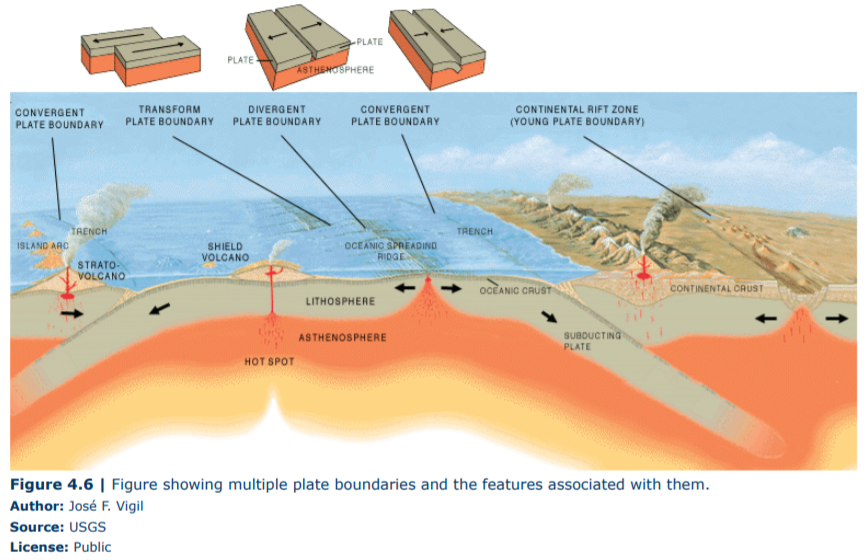4.8: Plate Boundaries
- Page ID
- 5491
Overview
Tectonic plates can interact in three different ways they can come together, they can pull apart, or they can slide by each other (Figure 4.6). The other factor that can be important is the composition of the plates (oceanic or continental crust) that are interacting as was explored in the previous section. These three types of motions along with the type of plates on each side of the boundary can produce vastly different structures and geologic events (Table 4.1).
Two plates that are moving apart from each other are called Divergent. Divergent boundaries are important because they are the way that continents split apart and break into separate plates as well as where new ocean crust is formed. If a divergent boundary forms within a continent that area stretches apart. This results in the area becoming thinner creating a topographic low or a valley. This extension is not a smooth process so the area is prone to earthquakes as well as volcanic activity. Eventually, the crust gets so thin it will rupture forming a gap between the plates, which will be filled with molten rock forming new oceanic crust. A thin and dense plate will be topographically low and will be covered in water forming a long and narrow sea. As the plates persist in pulling apart new crust is continually being formed at the plate boundary along an elevated crest known as a mid-oceanic ridge.
Two plates that are moving together are called Convergent. Convergent boundaries are important because they are the way distinctive plates can join (suture) together to form larger plates as well as where ocean crust is destroyed. The resulting structures we see at convergent boundaries depend on the types of tectonic plates. If two thick and lower density continental plates converge we get a large collision which results in mountains. This is a violent process resulting in many earthquakes, deformation (folds and faults) of rock, and the uplift of mountains. The rocks are also under immense pressure and heat and will eventually become stuck together as a single plate. If a continental plate and an ocean plate converge (continent-ocean convergent plate boundary) there will be subduction, where the oceanic plate sinks downward underneath the continental plate. This will result in several features including a deep trench near the subducting plate, abundant earthquakes, and the formation of magma which results in a line of volcanoes along the coast. Associated with this type of plate boundary is the Wadati-Benioff zone, a zone where earthquakes are produced; this zone ranges in depth from shallow (at the trench) to deep (~600km), indicating that the oceanic plate is sinking into the mantle. If two oceanic plates converge it will also result in subduction with similar features as were just discussed. The only exception will be that the volcanoes will appear on an oceanic plate and will eventually form islands along the tectonic boundary.
When the two plates slide past each other it is called a Transform boundary. This type of boundary differs from the previous two in that no new crust is being formed and no old crust is being destroyed. Therefore, there won’t be as many striking geologic features. Transform boundaries are often marked by abundant earthquakes that can be close to the surface as well as distinctive patterns of rivers that become offset as the land is moving underneath them. Transform boundaries are also often associated with mid-oceanic ridges. If the ridge has a jagged or stair-stepped edge, the pulling apart of the two tectonic plates will also result in transform motion as you can see in Figure 4.6.

| Table 4.1. Characteristics of the different Plate Boundaries | ||||
|
Boundary Type |
Plate Compositions |
Earthquake Depth |
Change in Crust |
Identifying Features |
|
Divergent |
Continent-Continent Ocean-Ocean |
Shallow Shallow |
No change Formation of New Crust |
Rift Valley and Volcanoes Ocean Ridges |
|
Convergent |
Continent-Continent Continent-Ocean Ocean-Ocean |
Shallow to Intermediate Shallow to Deep Shallow to Deep |
Metamorphism of Crust Melting of Crust Melting of Crust |
Mountains Trench and Coastal Volcanoes Trench and Volcanic Islands |
|
Transform |
Continent-Continent Ocean-Ocean |
Shallow Shallow |
No change No change |
Offset Rivers Often associated with Ocean ridges. |


